“portables” Opened Saturday, August 14th
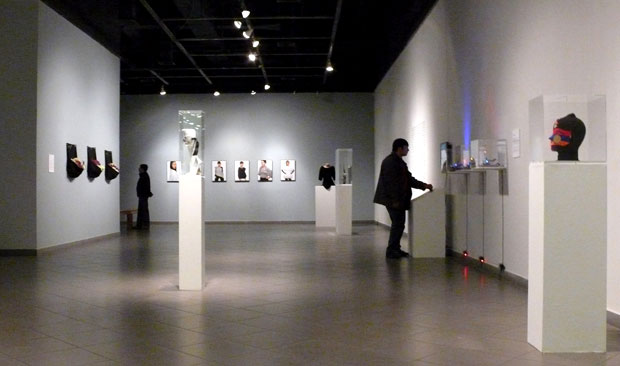
portables, Museo Nacional de Bellas Artes, Mall Plaza Vespucio
I received images from Ignacio Nieto, curator of the exhibition “portables” at the Museo Nacional de Bellas Artes, Mall Plaza Vespucio in Santiago, Chile. The gallery is a satellite gallery of the National Museum and it’s located inside a luxury mall. According to the statistics, this gallery of the Museum is well attended due to its location… Brilliant, if the people will not attend the museum, bring the museum to the people. As mentioned in an earlier post, the exhibition includes Michelle Teran, Chimbalab, Alejandra Perez, Carolina Pino, GraphTech, Otto Von Busch, Ricardo Miranda Zuniga and Kurt Olmstead.
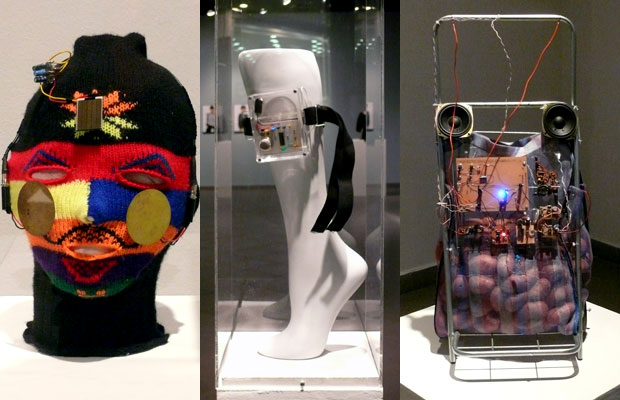
Ignacio selected a group of artists that are using electronics as a creative medium, specifically, creating portable electronics (hand-held or worn on the body). Above are details of works by noise artist, Alejandra Perez who created a sound mask, GraphTech who presented an over the limit alcohol device that calls a phone number in the U.S. when high alcohol levels are detected from a person’s breath and Chimbalab who created a mobile, potato-powered radio station.
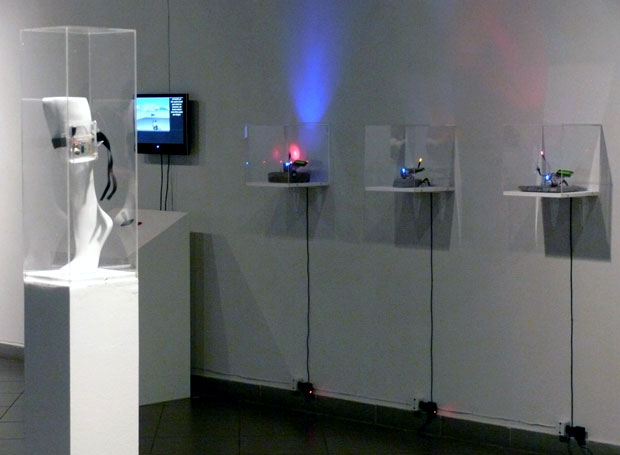
GraphTech, Ricardo Miranda Zuniga and Kurt Olmstead
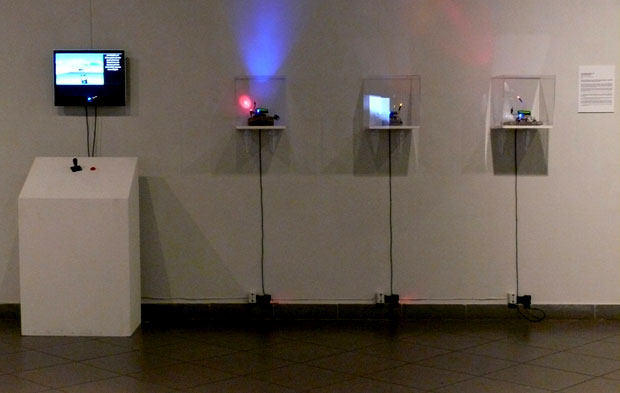
Miracle of Chile
The image above is my collaborative contribution. I worked with my old friend Kurt Olmstead to realize a project specific to Chile – “Miracle of Chile” which I’ve previously posted about. Our portion of the exhibition includes a virtual labyrinth that presents images taken by participants of what the “Miracle of Chile” is to them as reflected on the streets of Santiago, and three circuit boards with LCDs mounted onto tiles of the Santiago sidewalks.
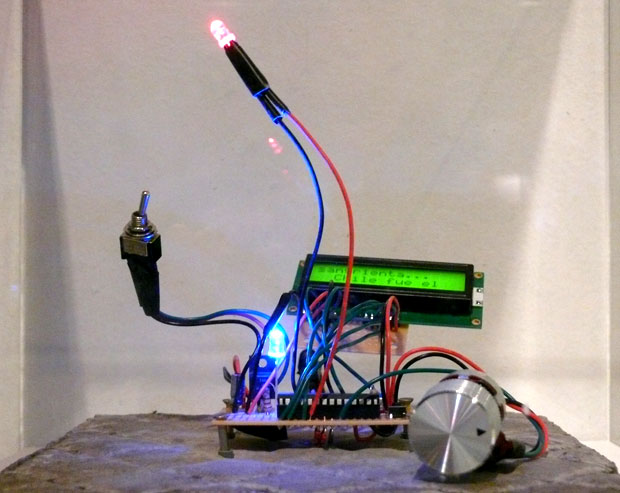
What is the Miracle of Chile?
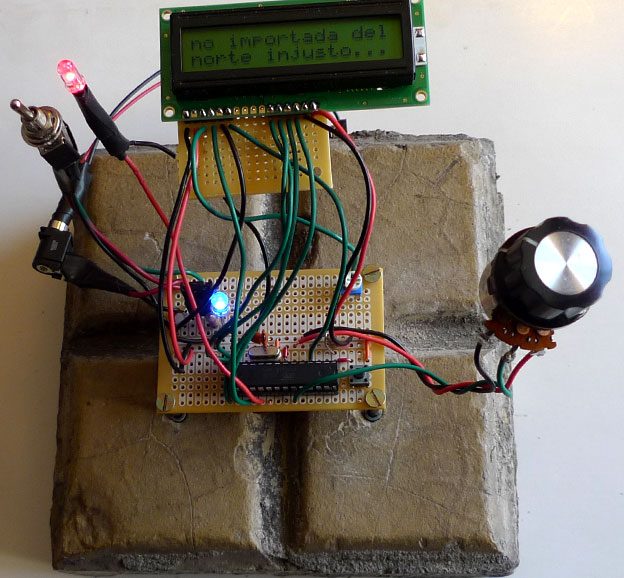
Last November I received an invitation from Ignacio Nieto to participate in an exhibition titled “portables” at the Museum of Fine Arts of Santiago. Last Friday I returned from Santiago, following two weeks of production.
Early this year, I contacted my old friend Kurt Olmstead to work with me on a project that I knew would be beyond the scope of anything that I could do alone within a period of several months. Kurt was on board and we started discussing the premise of the project – Chile as the laboratory for neoliberal economic philosophy of the Milton Friedman flavor. Kurt and I grew up in the midst of Reaganomics. In the 80s, Reagan and Thatcher embraced Friedman’s neoliberalism and Chile was framed as the example of what privatization, deregulation of the markets and cuts to social spending will do to control inflation and allow a nation’s economy to prosper. In 1981, Friedman declared the phrase “Miracle of Chile” to reflect the transformation of Chile’s economy through his neoliberal philosophy as implemented by the Chicago Boys, Chilean economists who studied under Friedman.
It is now 2010, we live in the midst of a global economic crisis and are now questioning the neoliberal economic formula. The art project consists of a workshop, public discussion, bus intervention and a virtual labyrinth. Each element asks participants in Chile to identify the Miracle of Chile in the scope of their city and personal lives. A documentation site is available at www.miracleofchile.com
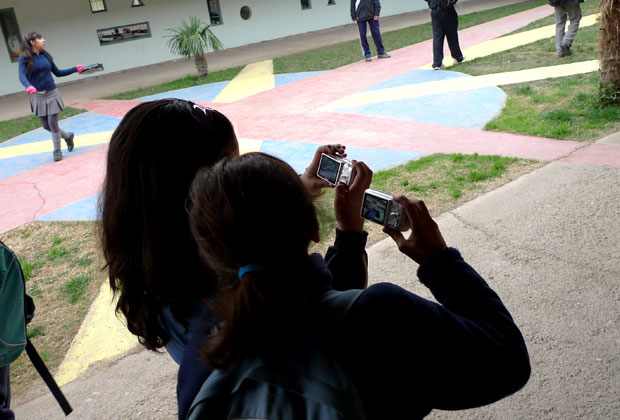
Two workshops were held as part of the project, one with middle school kids and a second at Matucana100 Cultural Center asked participants to document the Miracle of Chile in their public space.
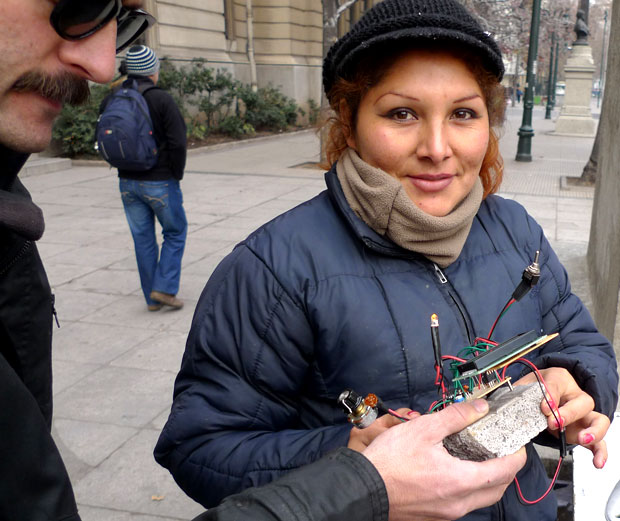
Street situations, an interactive sidewalk tile invites pedestrians to ask one another “What is the Miracle of Chile?”
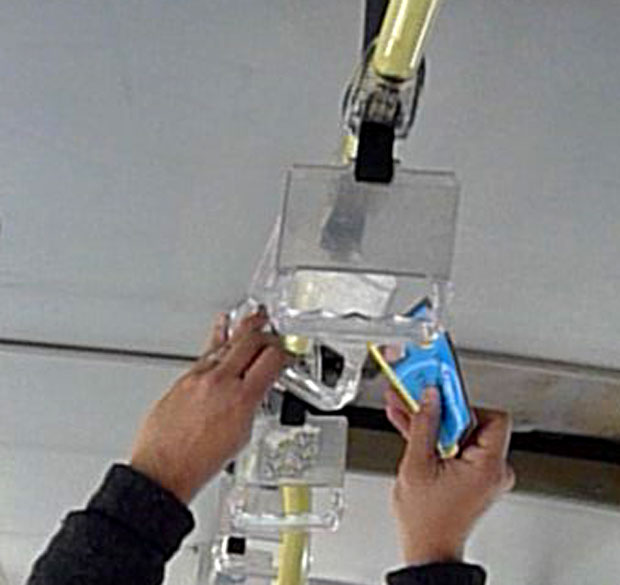
As an example of privatization of public space, a small bus intervention was executed on bus rider handles sold for advertisement.
“portables” comienza el 14 de agosto
La apertura para la exposicion portables es el sabado, 14 de agosto a las 18:00 horas en Museo Nacional de Bellas Artes, Mall Plaza Vespucio, Santiago, Chile y permanecera hasta el 19 de septiembre. Curada por Ignacio Nieto, el tema de la exposicion es artistas que usan y crean dispositivos como medio creativo. Portables presenta las obras de Michelle Teran, Chimbalab, Alejandra Perez, Carolina Pino, GraphTech, Otto Von Busch, Ricardo Miranda Zuniga and Kurt Olmstead (fotos abajo).
Yo estoy estrenando El Milagro de Chile, obra colaborativa con Kurt Olsmtead.
“portables” Opens Saturday August 14, Santiago, Chile
The exhibition “portables” opens August 14th at the Museo Nacional de Bellas Artes, Mall Plaza Vespucio and will run through September 19th. The show presents an array of artists using portable electronics as a creative medium and is curated by Ignacio Nieto. The show includes Michelle Teran, Chimbalab, Alejandra Perez, Carolina Pino, GraphTech, Otto Von Busch, Ricardo Miranda Zuniga and Kurt Olmstead.
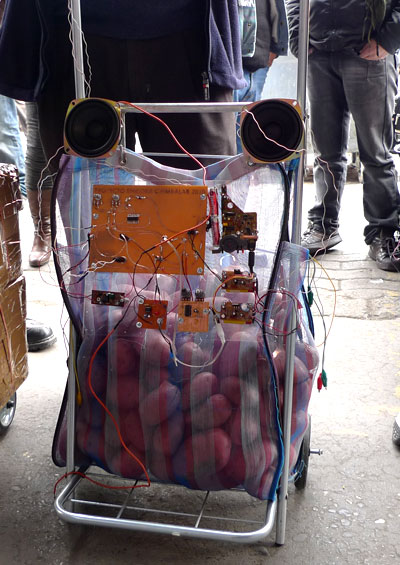
Chimba Lab takes their portable radio transmission through the market
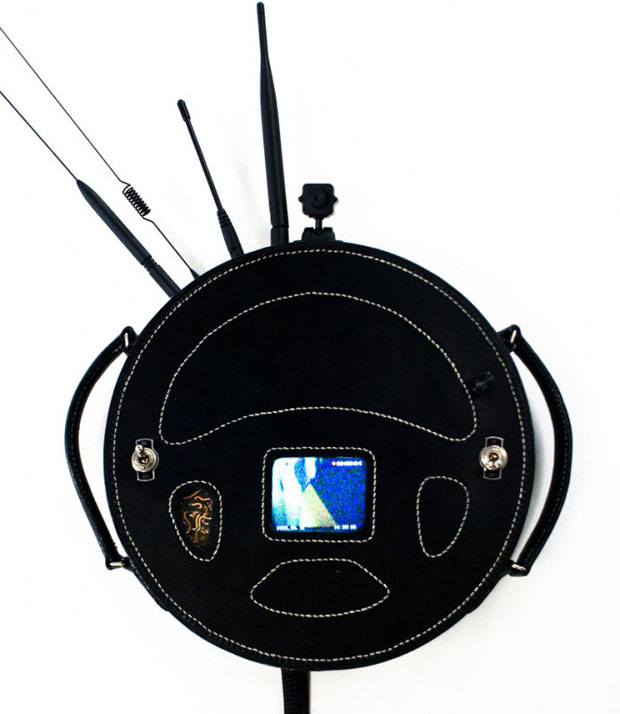
Beautifully encased CCTV viewer – a portable Panopticon
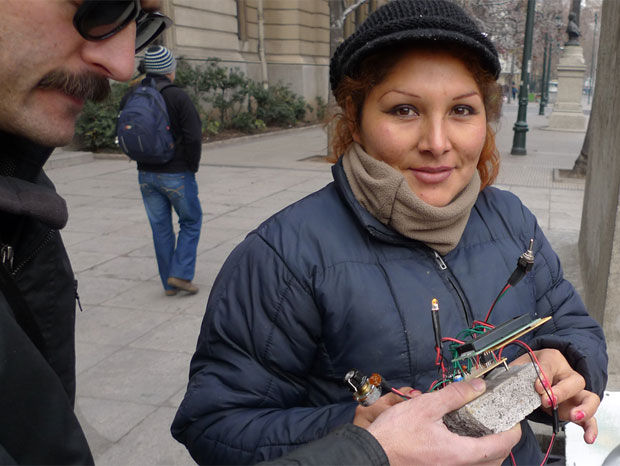
Pedestrians are questioned through a piece of sidewalk as electronic portable… What is the Miracle of Chile?
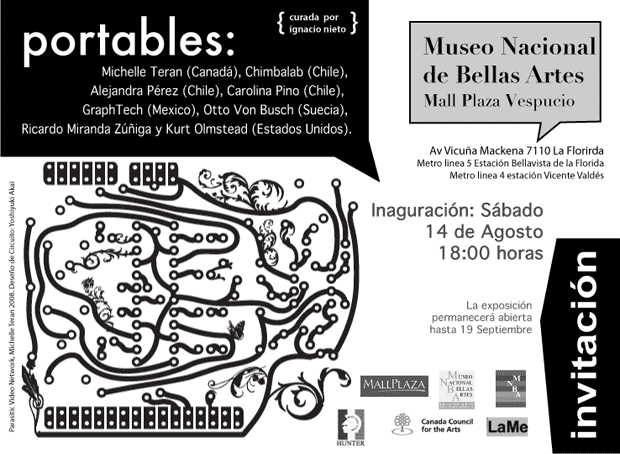
If in Santiago, check it out, if not, try the links in this entry…
Eight Hours in Lima
Kurt and I left San Francisco at 1:30am on July 26th, arrived in San Salvador around 7:30am and then borded a plane to Lima at 8:30am. We arrived in Lima in the early afternoon, perhaps 1pm and would not be catching our next flight until 10:30pm. So we headed for the downtown to check out the Museo del Convento de San Francisco and its catacombs. It was once the main graveyard of the city and you can still tour the catacombs and see the bones of city citizens buried below the church. As well as a great collection of paintings, an amazing library that is disintegrating and the architecture of the church itself.

Photos were not allowed, so we took pictures outside and then toured the downtown.
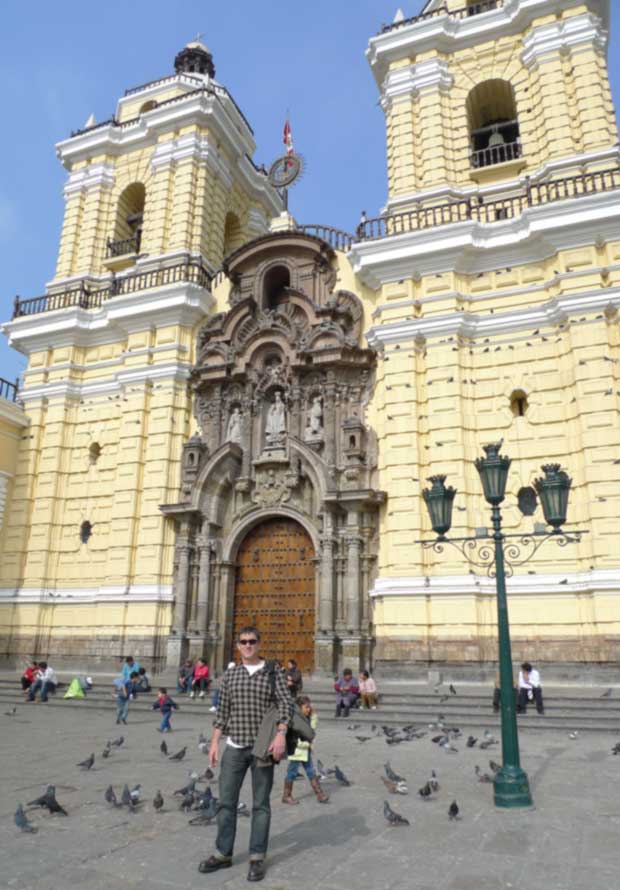
We had excellent ham sandwiches at EL Cordano, an old bar and restaurant near the president’s house. That’s the cook, behind Kurt’s head cutting our ham.
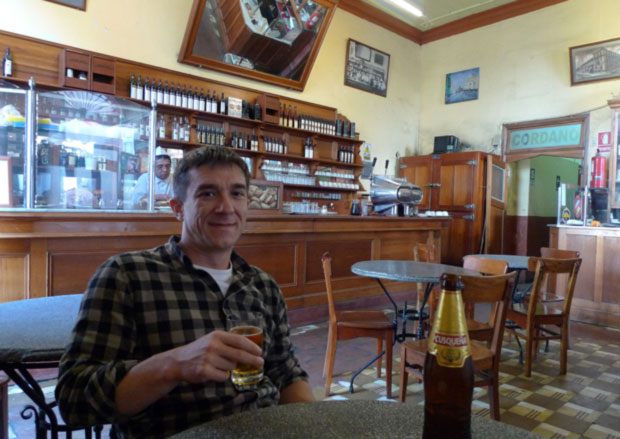
Then we headed to the central square and the rest of downtown and I bought a great wool sweater and a nice shirt for a fraction of what it would have cost me in NYC
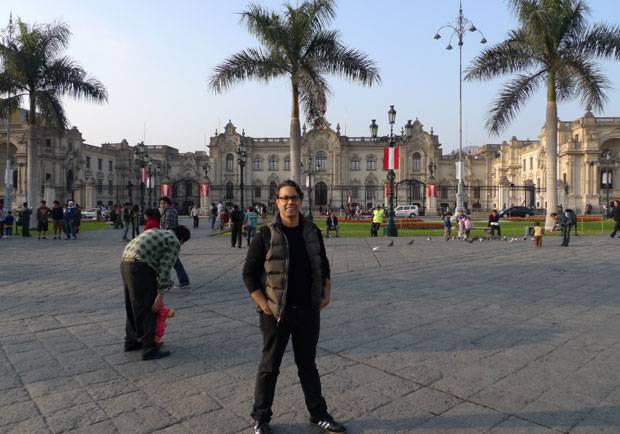
We hadn’t prepared for Lima and were surprised at the poverty of the capital. On the way in from the airport, many buildings appeared unfinished, abandoned or as if they had suffered a disaster. The general energy of the downtown was incredibly calm, which was surprising as they were about to celebrate their independence. The taxi drive back to the airport was one of the most horrific rides either of us had experienced, it was exhilarating and scary, Kurt tried to put his seatbelt on, but it didn’t work. I tried taking some photos, but it didn’t work:

twitterfountain: keyword “neoliberalism”
The Way To Work Is Now and Now and Now…
“Welcome…
To the truly mobile work force.
To the new paradigm.
Get the innovation right when it happens.
The way we work is now.
What will you choose?”
Whether it’s large companies or small start-ups, the transparency of profiteering on hype is clearer today than ever before. We recognize it as soon as we see it and yet, these people will jump on the latest buzz term to capitalize on vapor… Unfortunately investors will invest, naive management will be seduced and some will buy into these “Cloud” products.
This video is sickening to watch, be prepared to have a bunch of tools try to sound visionary and inspiring (and you really don’t want to witness the little dance moves):
Choosing the Cloud is Capitalism On Hyperdrive… It will make workaholics happy, and their children sad and neglected (although these are most likely people who only see their children on the weekends, so weekend time will be curtailed by emails, txts, mobile conferencing…) As Internet accessibility expands, the office is always at your fingertips.
But people needn’t accept this, a worker’s contract must be established, privacy and inaccessibility is necessary for the imagination… draw the line. Of course these CEOs will say that the Cloud saves time by establishing greater efficiency… don’t believe the hype. And if you really feel the need to jump into the clouds, just use Google. Although it’s not as pretty, Google is well ahead of these companies, and it’s likely to be around longer (and they’re already analyzing your searches anyhow).
I’m primarily reacting to this silly video and the hype revolving around “Cloud Computing.” After all, it’s the roll of entrepreneurs to try and capitalize on hype, to make quick money on tools that are already freely accessible or to cash in on naivety, laziness or ignorance. And if it’s a good product that facilitates some work flow, or has you log into less things, great… But underlying my reactionary response is the need for a critical perspective regarding ease of accessibility. And the pervasive business mentality of the need to always be connected that flows into all aspects of society (not just business)… It is time for a universal social contract to be established that allows the worker privacy and inaccessibility. Today, it’s simply too easy for young or vulnerable employees to be taken advantage of and be expected to be on call or online 24/7.
more from Boyer’s Understanding Media
You can also identify this phenomenon in the contemporary pressures of corporations with publicly traded stock to maintain and increase “shareholder value.” What matters most to these corporations’ managers are the metrics of profit and objective value monitored and determined by a new enormous, international financial services industry. What matters less, especially to most metrically inclined institutional investors, is how well the company has done for society, what the subjective value of its products are to its producers and consumers, it is the objective, quantifiable dimension of value that is the proverbial bottom line. Marx would see this as the essence of capitalism – the centralization of markets and money, the elevation of the quantitative, formal side of things and therefore “estrangement,” in human experience. In contemporary capitalist society, like it or not, the medial sphere of exchange and transaction reigns supreme, utilizing the formal, objective dimension of value to triumph over the poetic, and, for Marx, “human” dimension of value.
Understanding Media: A Popular Philosophy by Dominic Boyer
I’m reading Boyer’s Understanding Media book as I do research for a current project. Boyer calls the book an essay and it’s brief and clearly written… Below is a passage about the value of objects produced and distributed in a global market… it doesn’t present anything new, but I like the writing:
Marx recognized that every society at every point in history had some kind of gap between objective value and subjective value and he called this “estrangement.” But he asserted that capitalism, with its central institutions of wage labor and private property, made human estrangement total, since it reduced all or most human activity to activity oriented toward markets and money.
To understand how estrangement connects to the medial, try a small thought experiment. Think about your sneakers or, for that matter, any other thing you use routinely. Subjectively, what makes your sneaker valuable to you is their comfort, their ability to keep your feet dry and protected, and likely also the image or status they convey. But, none of these subjective needs an desires iv you a legitimate claim upon those shoes in a market-oriented society with institutionalized private property. What gives you a claim is your ability to pay their objective, market-determined price. How are you able to earn enough to buy them? ONly through some other kind of activity compensated by money. Does your need for money alter even if you don’t like the activity you specialize in? Sorry, no. But this seems normal since we’re socialized from an early age to feel that it’s impossible or at least very difficult to opt out of the monetary economy altogether.
And what are you really paying for in the price of those sneakers? It would require an enormous amount of detective work to determine that precisely but the answer would be something like: the market-determined costs of materials, labors, rent, management, machinery, storage, transport, advertising and marketing, among other inputs. None of these inputs have anything to do with your subjective need for shoes either, nor do they have much to do with the subjective value of the time and energy invested elsewhere in the making and marketing of those shoes by the suppliers of the raw materials, by the shoe assemblers, perhaps in Indonesia and China, by people involved in freighting the shoes between Asia and North America, by advertisers and marketers and sports-scientists affiliated with the sneaker company and, of course, the salespeople in the store where you purchased them.
At every link in the production chain, subjective values are coordinated by objective value, human interests and idiosyncrasies are converted into an abstract logic and language of supply, demand, price, utility, equivalence, value and so on. One of the key effects of this continuous conversion process is that we can use routine objects like our sneakers with no sense whatsoever of the many human hands that contributed to the production, passage, and marketing of them. And, yet, without those hands, no sneakers; the other side of a complex exchange system of specialized producers is that most of us do not have the time or skill to produce useful things like sneakers for ourselves.
pgs. 33-35
Natalya Serebrennikova Receives NBR Student Grant
My first year teaching at Hunter’s Department of Film and Media Studies is nearing an end, just a couple finals next week and then grading. As with any new position, it’s been a great deal of work and I’ve done a lot of curriculum planning.
One of the great pleasures is the quality of work from many of the students. The highlight has been a beautiful animation by Natalya Serebrennikova titled “Cicada”. The animation was executed in my Intro to 2D Animation course (it was the first time I taught the course, but have wanted to do so for sometime). Fortunately Natalya walked in with a story and art work in mind that she developed in Tim Portlock’s Graphic Novel class. With a great story and the aesthetic developed, it was really a matter of conquering the technical skills of animation and a bit of guidance.
I consider Natalya’s work an excellent example of various courses and faculty working together to help a student realize her vision.
Natalya was just awarded a National Board of Review Student Grant! Hopefully, I’ll have a few more great projects this semester.